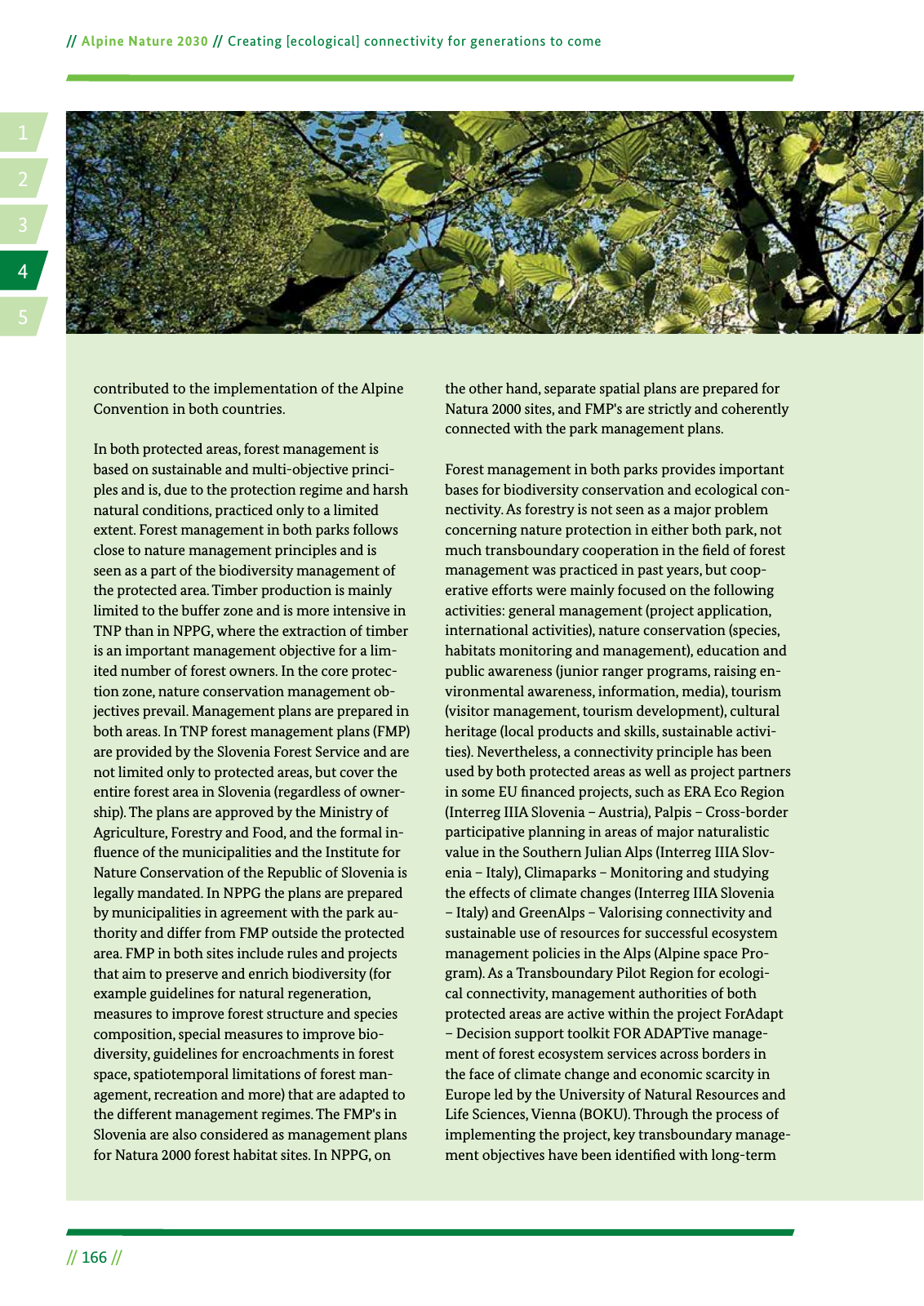14 2 5 3 Alpine Nature 2030 Creating ecological connectivity for generations to come 166 contributed to the implementation of the Alpine Convention in both countries In both protected areas forest management is based on sustainable and multi objective princi ples and is due to the protection regime and harsh natural conditions practiced only to a limited extent Forest management in both parks follows close to nature management principles and is seen as a part of the biodiversity management of the protected area Timber production is mainly limited to the buffer zone and is more intensive in TNP than in NPPG where the extraction of timber is an important management objective for a lim ited number of forest owners In the core protec tion zone nature conservation management ob jectives prevail Management plans are prepared in both areas In TNP forest management plans FMP are provided by the Slovenia Forest Service and are not limited only to protected areas but cover the entire forest area in Slovenia regardless of owner ship The plans are approved by the Ministry of Agriculture Forestry and Food and the formal in uence of the municipalities and the Institute for Nature Conservation of the Republic of Slovenia is legally mandated In NPPG the plans are prepared by municipalities in agreement with the park au thority and differ from FMP outside the protected area FMP in both sites include rules and projects that aim to preserve and enrich biodiversity for example guidelines for natural regeneration measures to improve forest structure and species composition special measures to improve bio diversity guidelines for encroachments in forest space spatiotemporal limitations of forest man agement recreation and more that are adapted to the different management regimes The FMP s in Slovenia are also considered as management plans for Natura 2000 forest habitat sites In NPPG on the other hand separate spatial plans are prepared for Natura 2000 sites and FMP s are strictly and coherently connected with the park management plans Forest management in both parks provides important bases for biodiversity conservation and ecological con nectivity As forestry is not seen as a major problem concerning nature protection in either both park not much transboundary cooperation in the eld of forest management was practiced in past years but coop erative efforts were mainly focused on the following activities general management project application international activities nature conservation species habitats monitoring and management education and public awareness junior ranger programs raising en vironmental awareness information media tourism visitor management tourism development cultural heritage local products and skills sustainable activi ties Nevertheless a connectivity principle has been used by both protected areas as well as project partners in some EU nanced projects such as ERA Eco Region Interreg IIIA Slovenia Austria Palpis Cross border participative planning in areas of major naturalistic value in the Southern Julian Alps Interreg IIIA Slov enia Italy Climaparks Monitoring and studying the effects of climate changes Interreg IIIA Slovenia Italy and GreenAlps Valorising connectivity and sustainable use of resources for successful ecosystem management policies in the Alps Alpine space Pro gram As a Transboundary Pilot Region for ecologi cal connectivity management authorities of both protected areas are active within the project ForAdapt Decision support toolkit FOR ADAPTive manage ment of forest ecosystem services across borders in the face of climate change and economic scarcity in Europe led by the University of Natural Resources and Life Sciences Vienna BOKU Through the process of implementing the project key transboundary manage ment objectives have been identi ed with long term

Hinweis: Dies ist eine maschinenlesbare No-Flash Ansicht.
Klicken Sie hier um zur Online-Version zu gelangen.
Klicken Sie hier um zur Online-Version zu gelangen.